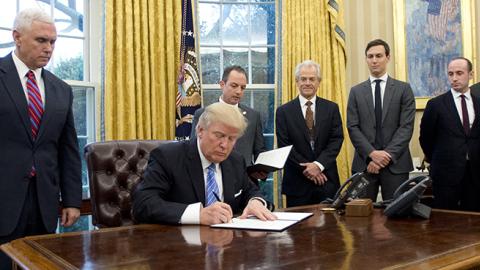Federal regulation has been growing mightily since the early 1970s, powered by statutes that delegate Congress’s lawmaking authority to mission-driven executive agencies. Beginning in 2008, the executive state achieved autonomy. The Bush administration during the financial crisis, and the Obama administration in normal times, decreed major policies on their own, without congressional authorization and sometimes even in defiance of statutory law.
President Trump might have been expected to continue the trend. As a candidate, he had railed against imperious Washington and promised to clear regulatory impediments to energy development and job creation. Yet he also was an avid protectionist, sounded sometimes like an antitrust populist, and had little to say about regulatory programs like those of the Federal Communications Commission and the Food and Drug Administration. He was contemptuous of Congress and admiring of President Obama’s unilateral methods. Clearly, this was to be a results-oriented, personality-centered presidency.
The record so far has been radically different. With some exceptions (such as business as usual on ethanol), and putting aside a few heavy-handed tweets (such as raising the idea of revoking broadcast licenses from purveyors of “fake news”), President Trump has proved to be a full-spectrum deregulator. His administration has been punctilious about the institutional prerogatives of Congress and the courts. Today there is a serious prospect of restoring the constitutional status quo ante and reversing what seemed to be an inexorable regulatory expansion. Consider three leading indicators.
First, Mr. Trump has appointed regulatory chiefs who are exceptionally well-qualified and are determined reformers. Deregulation succeeds only when political officials are earnestly committed to the broad public missions of their agencies—and equally committed to ferreting out bureaucratic excesses, ideological detours and interest-group machinations.
Mr. Trump’s new agency leaders are making these distinctions and pushing ahead: FDA Commissioner Scott Gottlieb on facilitating generic drug competition and incorporating “real-world evidence” in reviewing new medications and devices; FCC Chairman Ajit Pai on lifting public-utility controls from the internet and ownership restrictions from the media; Education Secretary Betsy DeVos on correcting the abuses of Title IX; Interior Secretary Ryan Zinke on active forest management and multiple use of public lands; Environmental Protection Agency Administrator Scott Pruitt on ending sweetheart legal settlements and putting the misbegotten Clean Power Plan out of its misery; Transportation Secretary Elaine Chao on modernizing air-traffic control and streamlining permit reviews. All are outstanding examples of regulatory statesmanship.
Second, the Trump administration is turning back from unilateral lawmaking. Mr. Obama made several aggressive excursions into this dangerous territory. He issued orders shielding certain classes of illegal aliens from deportation, spent billions without a congressional appropriation to subsidize insurance plans on the ObamaCare exchanges, and imposed the EPA’s Clean Power Plan. Each was a substantive policy that Congress had considered and declined to enact. Each was justified by legal arguments that administration officials conceded to be novel and that many impartial experts (including those who favored the policies on the merits) regarded as risible. Each ran into strong resistance from the courts.
Mr. Trump is returning immigration policy and ObamaCare appropriations to Congress, where they belong. His EPA has proposed to withdraw the Clean Power Plan and replace it with something else, based on a solid analysis of what the Clean Air Act actually authorizes the agency to do. The constitutional significance of these steps has been masked by media accounts and interest-group perseverations that focus on politics and policy, not the separation of powers. But Mr. Trump has made clear that he would be happy to see Congress enact legal status for aliens who were brought to the U.S. as children, as well as health-insurance subsidies, if legislated in conjunction with other policies he favors. Global-warming policy is a work in progress in both the administration and Congress.
Perhaps Mr. Trump was led to summon Congress on these momentous matters by political calculations and his own policy preferences. That would be fine—the Constitution depends on political self-interest to sustain its structure. But one should not gainsay the administration’s broader concerns with the trajectory of unbounded executive government. Neomi Rao, who leads the influential Office of Information and Regulatory Affairs at the Office of Management and Budget, is a constitutional scholar and a deep critic of congressional overdelegation. She has mused, with fine subtlety, that the Trump administration aims to make the federal government “more constitutional.”
A third indicator is the introduction of regulatory budgeting, which sounds tedious but is potentially revolutionary. The idea goes back to the late 1970s, when the new health, safety and environmental agencies were first issuing rules that required private businesses and individuals to spend tens of millions of dollars or more. It seemed anomalous that this should be free of the disciplines of taxing, appropriating and budgeting that applied to direct expenditures. Jimmy Carter’s commerce secretary, Juanita Kreps, proposed a regulatory budget as a good-government measure; Sen. Lloyd Bentsen (D., Texas) introduced legislation; and several academics (myself included) worked out the theory and practicalities in congressional reports and journal articles.
The idea never went anywhere. One problem was the inherent sponginess of regulatory cost estimates, which seemed inconsistent with the clear dollar metrics that drive spending budgets. Another was the herculean task of tracking the aggregate cost of the stock and flow of agency rules. When Ronald Reagan came into office, he instead imposed a cost-benefit test on individual rules, enforced by OMB. All subsequent administrations essentially continued that approach.
But several developments have combined to revive the budgeting idea in a more workable form. Although the cost-benefit test has improved regulation at the margins, it has become progressively less constraining over time and proved manifestly inadequate to the dynamics of large-scale regulatory growth. The Obama administration corrupted cost-benefit analysis, inflating benefits while minimizing costs, to sell a host of dubious energy and environmental rules. Moreover, the cost-benefit test applies only to new rules, leaving established and often obsolete regulations untouched. Most administrations, including Mr. Obama’s, have compensated by nudging agencies to review their regulatory accumulations, but with generally meager results.
At the same time, a hybrid form of regulatory budgeting has been adopted with some success in Britain and Canada, while kindling interest in the U.S., notably from Sen. Mark Warner (D., Va.) and House Budget Committee Republicans. Under this variant, agencies may issue new rules only by simultaneously withdrawing some existing rules, with the estimates of the costs imposed and saved used to make the trade-off commensurate. So the budgeting begins by counting rules and employs cost estimates only for incremental actions, but it creates incentives for agencies to assess the effectiveness of their existing regulations and to set priorities.
President Trump’s regulatory budget is of this form. In an executive order issued shortly after taking office, he directed that unless a statute requires otherwise, agencies may issue new regulations only by rescinding two or more existing regulations, with net costs held to an annual budget. His budget for fiscal 2017 was zero, which was easily met after agencies issued few new rules and lawmakers rescinded many under the Congressional Review Act. Now, an OMB directive from Ms. Rao in September has set a goal of “net reduction in total incremental regulatory costs” in fiscal 2018.
The Trump regulatory budget is still in beta version. Many technical and procedural issues remain to be worked out regarding cost estimation, the timing of new versus rescinded rules, and the interplay of the regulatory budget with the cost-benefit test and the requirements of administrative law. As the new protocols take shape, it is important to understand their potential for reversing the heretofore uninterrupted expansion of the regulatory state.
Budget cutting is conventional in business. Doing more next year at 5% less expense is private-sector progressivism—a means of pursuing continuous improvement in operating methods and market performance. But the approach is unfamiliar in government, where budgeting is conceived of as adding to an inflation-adjusted baseline.
Even more alien in government is considering the costs its rules impose on others. The regulatory agency’s ethos is to extend controls to an ever-widening range of entities and activities while tightening them continuously along every margin.
This mindset is by no means universal, but it is the source of many regulatory pathologies: indifference to the other worthy purposes competing for the limited resources of regulated parties; obliviousness to the unintended, counterproductive ways that markets and people respond to the rules; and disdain for private social and economic forces that advance agency goals independently and sometimes outflank them. The Clean Power Plan was stayed by the Supreme Court in February 2016—and U.S. greenhouse-gas emissions have since fallen by more than the plan projected.
The cost-benefit standard is a useful counterweight, but a regulatory budget goes much deeper. It aims not only at restraint but at reforming agency culture. Faced with a two-for-one rule and a requirement to reduce annual costs, regulators will be obliged to monitor the effectiveness of all their rules and to make choices. There will be efforts to game the system, as there always are. But the best game in town may be to shift from maximizing rules to maximizing, within the budget constraint, environmental quality, public health, workplace safety and other regulatory goals. And, in all events, there will be fewer rules!
Many readers may be puzzled that our tempestuous president should preside over the principled, calibrated regulatory reform described here. I have a hypothesis. Perhaps our first businessman-president, whatever his troubles in dealing with Congress, foreign leaders and other outside forces, is comfortable and proficient in managing his own enterprise, which is now the executive branch. He devoted unusual personal attention to his regulatory appointments, including those whose programs did not figure in his campaign strategy. He gives his subordinates wide running room, checks in with questions and pep talks, and likes management systems and metrics. He may even understand that modern presidents have become too powerful for their own good and can benefit from sharing responsibility with Congress.
It may all come to naught. Mr. Trump’s officials may get worn down and his regulatory budget mired in bureaucracy. He may eventually lose patience with Congress and claim kingly prerogatives, as Mr. Obama did.
But if my hypothesis is correct, it is more likely that he will go further in making the administrative state less stultifying and “more constitutional.” He could, for example, follow the Supreme Court’s lead in the Clean Power Plan case and require that all new rules take effect only after legal challenges have been resolved. He could apply White House regulatory policies and budgeting to the “independent agencies” such as the FCC and Securities and Exchange Commission. He could renounce the many instances of direct executive taxing and appropriation-free spending that have grown in recent decades. He could, rather than fussing over his adversaries’ broadcast licenses, liberate all spectrum licenses from their antiquated, innovation-deadening use restrictions.
The list is long of salutary regulatory reforms that are well within the jurisdiction of our federal CEO. Pursuing them energetically could restore the good name of executive initiative.














